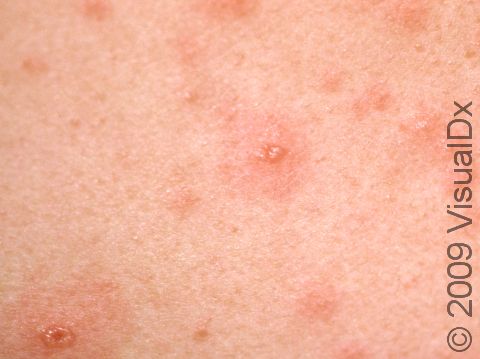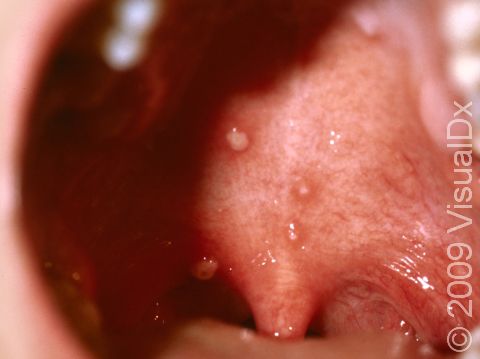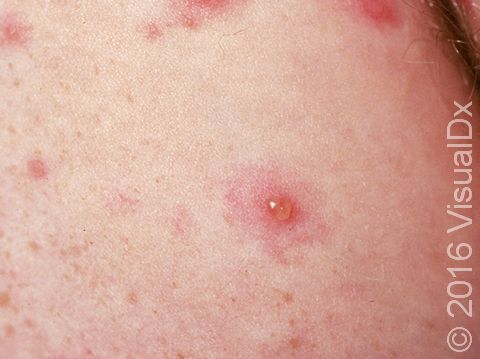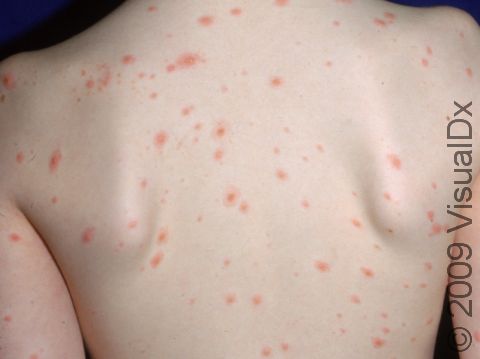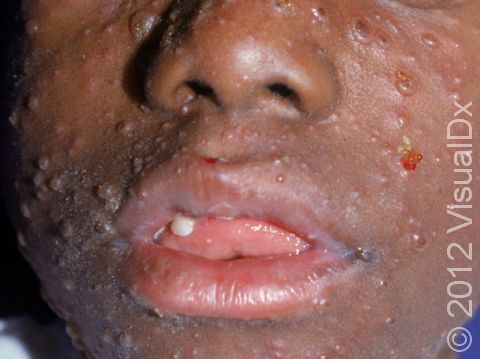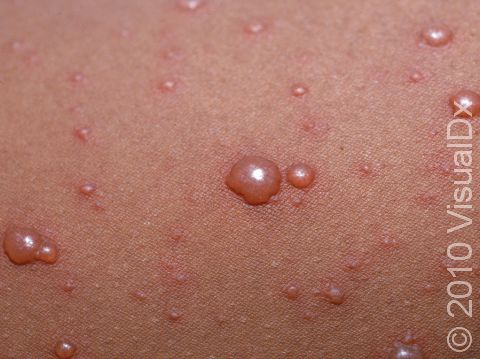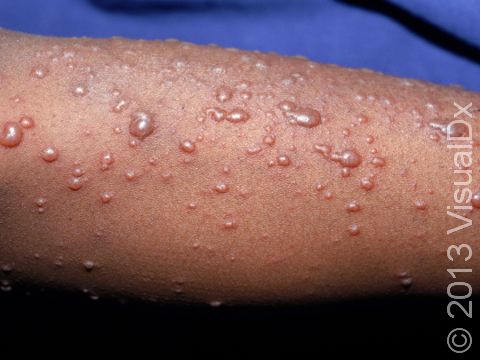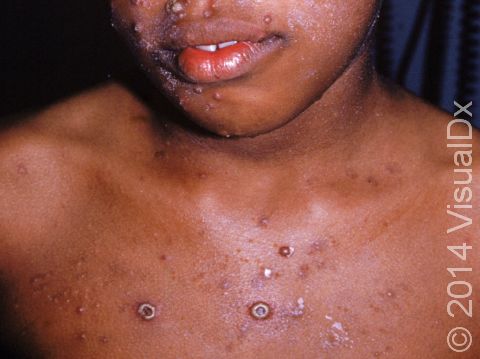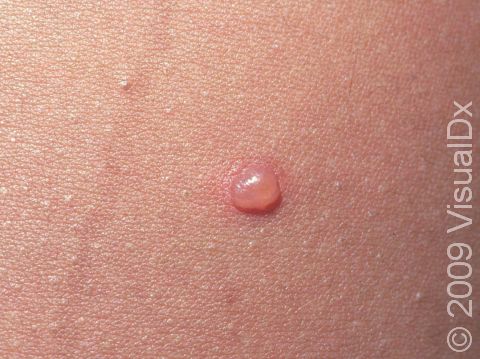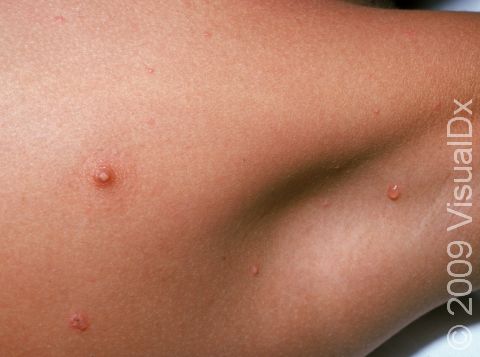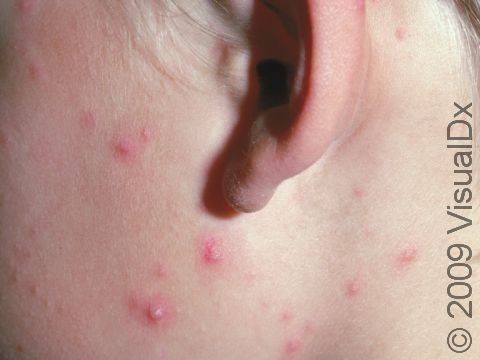Chickenpox (Varicella)
Chickenpox (varicella) is an infectious disease caused by the varicella-zoster virus that goes away on its own. Infection spreads among humans through fluids from the airways, such as from coughing and sneezing, with non-infected household members at high risk of becoming infected as well. The development (incubation) period is 14–16 days, and the first sign of disease is a rash. People are considered contagious for 2–5 days before the onset of skin lesions and for 6 days after the last series of rashes have appeared.
The most common complication is infection of lesions with bacteria. Rare complications include lung infection (pneumonia) or brain infection (encephalitis). Children who have weak immune systems, eczema, or recent sunburns have more severe symptoms. Because the virus remains resting (latent) in the parts of nerves that are near the spinal cord (nerve roots) for life, about 1 in 10 adults will get shingles (zoster) when the virus reappears, usually under conditions of stress to the body.
After having chickenpox, a person is usually immune for life, although reinfection is possible.
Who's At Risk?
Chickenpox occurs most commonly in children under 10. Those under 1 year of age (whose mothers have had chickenpox before) are not usually infected, as they still have some immunity from their mother’s antibodies, which were transferred to them before birth.
The chickenpox vaccine has been part of routine childhood vaccinations (at age 12–18 months) since 1995, but many children have still not been vaccinated. About 85% of children who have been vaccinated avoid infection, but even if they do show symptoms, they are generally mild. Most infections occur from March to May.
Signs & Symptoms
Most children act sick with fever and vague symptoms (loss of appetite, headache, belly ache) for 1–2 days before they start to break out with a rash. These symptoms last for 2–4 days after the rash appears.
An early pink-to-red, flat, small spot rapidly becomes bumpy and then blisters with a surrounding halo of redness. The spots usually appear first on the trunk or scalp. Linings of body cavities, such as the mouth or nose (mucous membranes), palms, and soles, can have a few lesions. The average child develops a few hundred blisters, most of which heal without leaving scars. A child who has had the chickenpox vaccine will have far fewer lesions.
The blister is usually described as looking like a dewdrop on a rose petal. The blister area (vesicle) is thin-walled and easily broken. Blisters become cloudy and then crust over, with healing completed within 1–3 weeks. Lesions often occur in 3 or more successive series (crops). Lesions in different stages of development may occur at the same time.
Self-Care Guidelines
Since the illness resolves on its own after 1–3 weeks, it is most important to keep the child comfortable and to discourage scratching, which can cause infection and scars.
For itching:
- Oatmeal baths in lukewarm water
- Oral antihistamines (diphenhydramine, chlorpheniramine)
- Clip the child’s fingernails
- Apply calamine lotion
- DO NOT USE lotions containing antihistamines or lidocaine, as they are no more effective than the previous measures and might cause allergic reactions later on.
For pain and fever:
- Use acetaminophen (eg, Tylenol).
- DO NOT USE aspirin in children aged 18 years or younger, as the use of aspirin in children with chickenpox has been associated with Reye syndrome, a severe disease.
- The American Academy of Pediatrics recommends AVOIDING treatment with ibuprofen (eg, Advil) if possible because it has been associated with life-threatening bacterial skin infections.
Because chickenpox is highly contagious, keep the child at home and resting until symptoms are gone and all blisters are dried up. Avoid any contact between your child and pregnant women who have never had chickenpox, newborns, or people who have a weak immune system or eczema. Once all the blisters have dried up into scabs, the child is not considered contagious to others.
Treatments
Antiviral medication may be given if the child is seen early (during the first day of the rash) for children at higher risk for more severe chickenpox infection (those with asthma, eczema, recent sunburn, children taking corticosteroids on a regular basis, and those with weak immune systems).
Visit Urgency
Most infections do not require treatment.
If there are adults or teens in the household who have never had chickenpox or people with eczema, asthma, or a weakened immune system, have them contact their doctor, as they may require antiviral medication. This usually needs to be done early (during the first day of the rash).
Call your child’s doctor if:
- He or she has eczema, asthma, or a weakened immune system.
- The fever lasts more than 4 days or exceeds 102 degrees Fahrenheit.
- Any rash areas look red, swollen, and leak pus.
- He or she has a severe cough, vomiting, headache, drowsiness, confusion, stiff neck, trouble looking at bright lights, or difficulty walking or breathing.
Trusted Links
References
Bolognia, Jean L., ed. Dermatology, pp.1241-1243. New York: Mosby, 2003.
Freedberg, Irwin M., ed. Fitzpatrick’s Dermatology in General Medicine. 6th ed. pp.2070, 2080-2081, 2434-2437. New York: McGraw-Hill, 2003.
Last modified on April 5th, 2023 at 9:02 am

Not sure what to look for?
Try our new Rash and Skin Condition Finder
